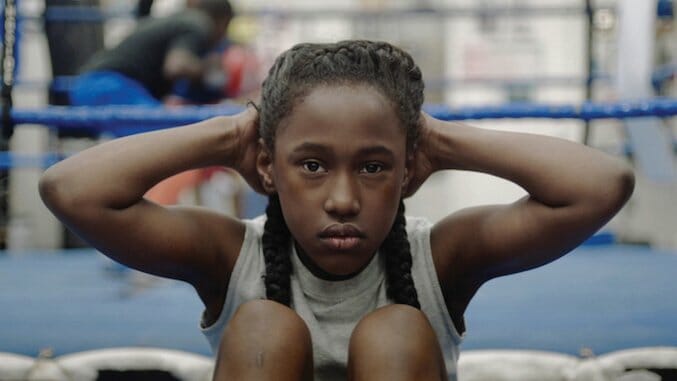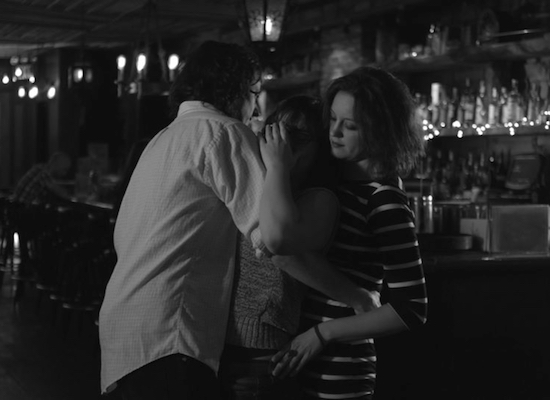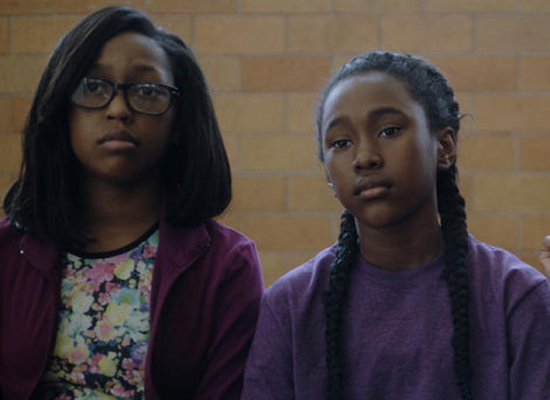In Spotlight: DPs on the Rise
Three breakout cinematographers from the Rooftop Films Summer Series discuss their craft, collaborators and more
Movies Features
Over here at Paste, we always enjoy finding artists on the rise. Often the best place to discover those new talents is at film festivals. This week the Rooftop Films Summer Series, which was founded by Dan Nuxoll and Mark Elijah Rosenberg, celebrates its 20th anniversary. Over the last two decades, the lineup has featured some of the most funky, fantastic and undiscovered pieces of cinema in the festival scene.
Last year we did a piece on a few of the directorial talents of the event, such as Sean Baker and Zachary Treitz. This time around, we feature a few cinematographers who stood out over the summer, chatting with Michael Simmonds of White Girl, Amy Bench of Bad at Dancing, and Paul Yee of The Fits. Each DP has a vision and style we found incredibly unique and exciting.
Michael Simmonds, White Girl

Michael Simmonds has been on our radar since his work on At Any Price, Deep Powder and Ramin Bahrani’s Man Push Cart. His latest project, Elizabeth Wood’s feature debut White Girl, centers on Leah (Morgan Saylor), a college student in New York City with mermaid hair—think Daryl Hannah in Splash—and an affinity for testing her limits. But Wood’s work isn’t your typical manic-pixie-girl-likes-to-party. Through her collaboration with Simmonds, the narrative unfolds like a fairy tale gone wrong, exploring serious issues with economic classes and consequences. Soon, Leah realizes that in NYC, danger can be right under your nose. Literally.
The Collaborator
The first time I met Liz [Wood] was after lecturing at Ramin Bahrani’s Columbia University class. A 5-foot-nothing, redheaded, young student got in my face and yapped away with the confidence of a seasoned director. I did not know that she would be the person I interviewed for years later. She reminded me of the encounter, which I immediately remembered.
I remember that she had/has an ability to get to know strangers and build trust instantly. I would come out of the bathroom and she would be best friends with the waiter in the five minutes I was gone. I realized very early on that this director had no interest in technical filmmaking, but rather she had the ability and enjoyed getting people to do things. That is the heart of directing. In fact, her favorite pastime is getting people to take their clothes off in photo booths in bars.
The Process
There were no storyboards or shot lists. Liz would block out the scene with the actors. I would watch and give my two cents. We all would discuss, and then I would put the camera on my shoulder and present Liz with a way to cover it. She would give feedback and then we would rock ’n‘ roll. Preparation in the technical sense is overrated.
The Visual
I wanted to work with color on White Girl. I felt it would match the mood of the film to use color in a dynamic way. I did not want to [do] a gray 1970s NYC, but a vibrant and youthful one. Justin [Kemper, the film’s gaffer] played a key role in choosing out the different gels we would play with. Gels on an indie film are a precious commodity so we had to be very specific with what we used and how much of it.
The docu vibe is based on not doing “shot/reverse shot.” Shot/reverse shot is how most narrative films are told. There is nothing “wrong” with that, but it definitely works better for films where the storyline is based in the dialogue and the audience must follow it closely. Man Push Cart uses extremely long lenses, long takes and has an observational approach, while White Girl uses a handheld camera, physically close to the actors, which is intended to make it feel more immediate, personal and experiential.
The Emotion
The prep Liz and I would do would be going over the script and understanding what each scene was doing emotionally. I really don’t know where to put a camera or how to light until I truly understand the emotion and narrative function of a scene.
I Wish I Would Have…
I like the way the film turned out. I wish I could have spent a little longer on the fight at the end of the film. I would have liked some shots on the overhead train to cut in with the violence. I think it would have been more emotional that way. I also would have liked a shot of the violence from the moving train’s perspective.
What’s Next
I have been very fortunate in my life. I have had a blast at work and enjoy what I do. I have been lucky enough to work with really cool and talented people, and I hope to continue do the same with more and more resources at my disposal.
Amy Bench, Bad at Dancing

Paste checked out Rooftop’s “This Is What We Mean By Short Films” block earlier this summer and found filmmaker Joanna Arnow’s film Bad at Dancing hilarious and compelling. Her DP, Amy Bench, delivered visuals with the delicacy of Frances Ha—black and white can be hard these days—and the humor of Broad City were it a 1920s silent film. It sounds a bit wacky, but it totally works, exploring complex issues of sex, the female body and friendships. Bench, who currently resides in Texas, has worked on films like Sundance favorite Frank, and another Rooftop film, Holy Hell. In Bad at Dancing, Joanna, played by the filmmaker herself, shares an apartment with a couple and is the ultimate third wheel. Through the story, she tries to be included—however awkward the situation.
The Collaborator
[Joanna and I] met through a mutual filmmaker friend in NYC while I was living there, so I knew her for a few years before we worked on the film. We hung out socially and worked together on a few nonprofit for-hire jobs. I remember once borrowing a lav from Joanna for a project. When the batteries went dead, I threw them away and put new ones in. When I returned the lavs, Joanna looked inside and asked, “Where are the rechargeables?” Oops. Now I always check my batteries.
The Process
When I first read Joanna’s script, I was struck by its level of intimacy, not just on a physical level, but on an emotional one. I hadn’t seen a character quite like the one Joanna played in a film before, and I knew that it was special and that I wanted to be a part of it. Joanna has talked a lot about the “leader/follower” dynamic in her own friend groups and was interested in exploring that dynamic on film. It is interesting that that dynamic is taken to places that are usually considered private, especially when nudity is concerned: the bathroom and the bedroom. This is where the film draws its power. By pushing our normative boundaries, and framing sexuality in such an absurd light, the film puts each viewer square in the face of his or her own comfort level with sexuality, openness, and boundaries.
The Visual
A Taiwanese film called Vive L’Amour was a main source of inspiration for the feel of the film. Vive L’Amour was shot in color, but is visually very spare with slightly awkward framing at times. Particularly the bedroom scenes in Bad at Dancing adhere to this aesthetic, but all the scenes in Bad at Dancing have shots that are very spare and imbalanced in some way.
The Emotion
Joanna wanted the film to feel almost archetypal—like yes, these are characters, but they are also stand-ins for all of us. And to make it black and white really emphasized the symbolic nature of each of the characters. Staying wide for long periods of time also adds to the surreal feeling we were going for. On an emotional level, there is more distance and isolation in a wide shot, as well as a distinct separation or pairing off of characters. Joanna was often visually disconnected from Eleanore and Keith [Pienta and Poulson, the two other actors in the film], and in the wides, we see her try to break that boundary.
I Wish I Would Have…
The scene that sticks with me the least is the one in the bar—but it’s also the one scene that’s outside the apartment, the familiar world of the three characters, so maybe that’s why it feels so different.
Part of the intimacy of the film stems from it being largely set in bedrooms and the bathroom, which in New York are even more private than normal given that they are generally small rooms. In New York, people spend a lot of their “social” time out of the house. That’s why the bar scene feels so different—it’s so not an intimate space, but rather a very public kind of “living room.”
What’s Next
To always absorb and experiment. I work in both film and photography, and each informs the other. My aspirations are to work with people who make good work, who are good people telling interesting, innovative stories. I’ve definitely run across people at festivals and through friends that I’d love to work with: Sophia Takal (I can’t wait to see Always Shine), Josephine Decker, Frank Mosley…
[The Golden Rut] just got “Project of the Day” on Indiewire, which is exciting. It’s a fun, lighthearted comedy that I shot with friends here in Austin. It’s their first feature, and speaks to the struggles artists have here in Austin—even though we’re considered a creative center, we don’t have the money or opportunity associated with larger cities, namely N.Y. or L.A. So it’s pretty autobiographical and I think a lot of people can relate to it.
Paul Yee, The Fits

It’s hard to believe The Fits is Paul Yee’s first feature as a DP. The precision in which he frames each shot, utilizes the camera in harmony with the action of the narrative and handles emotional scenes is impressive. Yee has worked in NYC previously as a gaffer on Borderline Films’ Afterschool and doing additional photography for Lena Dunham and Matt Wolf’s short It’s Me, Hilary: The Man Who Drew Eloise. The Fits is also the first feature for its director, Anna Rose Holmer, who met Yee during their time as NYU film students. The story explores 11-year-old Toni’s journey when she joins a local dance troupe. Trading her boxing gloves for choreography, she becomes entranced emotionally and then physically by the team when they start experiencing strange fits.
The Process
Honestly, the thing that excited me the most about going into The Fits was the opportunity to make a movie with so many old friends and collaborators. I’d been pursuing a feature film for a while, so I feel incredibly fortunate that my first one was with Anna, with whom I’ve had a close relationship for years. As a result, I felt a constant pressure to perform well; I just didn’t want to let down my friends. So I guess my greatest fear was failure. We also stayed in an Airbnb where the lights would turn on and off on their own, which was creepy. So the second greatest fear was ghosts.
The Visual
There are so many reasons why the AMIRA [camera] was perfect for our production: accurate color rendition and expanded latitude for natural light situations and a compact build for a small camera department. Anna knew from the outset that she wanted camera movement but that none of it should be handheld. I think that committing to a dolly and choreographed Steadicam made the visual storytelling more formal and confident. Having that precise control over the camera instills the movie with a sense of inevitability—as if the camera is building inertia along a predetermined path.
In pre-production, we watched some psychological horror movies to explore how an unseen presence can manifest on screen. We wanted the community center to feel like it had a presence—not quite haunted, but breathing and alive. In many scenes, the camera moves independently of Toni, often before she enters the frame and sometimes past her, making the camera feel like it has an independent point of view, following Toni like a floating apparition. There’s also a great deal of dolly and zoom shots that move in on Toni that make the world feel like it’s closing in on her and collapsing.
The Emotion
The Fits is very much a psychological portrait of Toni. We wanted the camerawork to be an extension of that experience. We used a set of uncoated Cooke primes [lenses] that have weird imperfections like aberrant bokeh, soft flares, and peripheral vignette—features that are technically flaws that are also beautiful in their own way. We also frequently brought Toni closer and closer to the lens to throw the background into soft focus, contributing to the sense of isolation.
Really though, Royalty [Hightower, who plays Toni] is just an exceptional actress, especially given her age and relative experience. All of the fancy camera[work] just reinforces her brilliant performance.
I Wish I Would Have…
I’d probably revisit some of the exterior scenes that we were forced to shoot in the direct midday sun due to our restrictive schedule. That bright sunny look doesn’t quite fit the tone of the movie to me.
This is probably too specific of an answer, but I regret that I didn’t test our lenses before the shoot. For budget reasons, we used a newer compact zoom lens that I feel is much flatter and crisper from the primes we used to shoot the majority of the film.
What’s Next
As a cinematographer, I’m mostly interested in collaborating with directors who want to tell unique stories about underrepresented characters. I would love to help put more minorities on the screen in any way possible.
Meredith Alloway is a Texas native and a freelance contributor for Paste, Flaunt, Complex, Nylon, CraveOnline, Press Play on Indiewire and The Script Lab. She writes for both TV and film and will always be an unabashed Shakespeare nerd. You can follow her on Twitter.